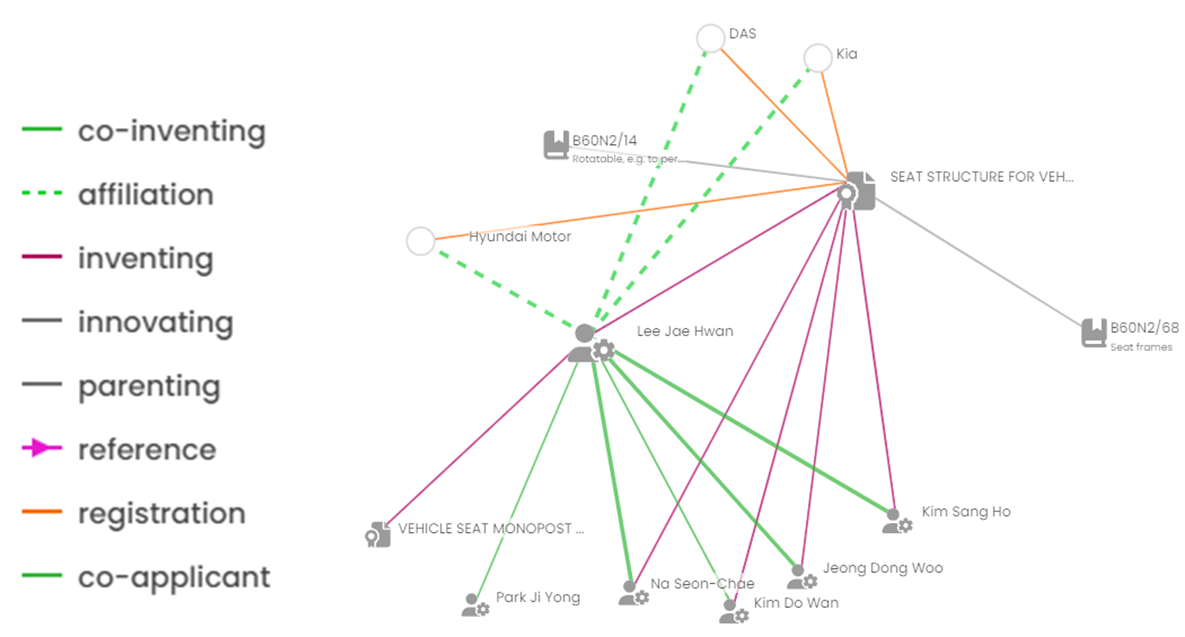Exploit the results of a patent search using the different filters available.
The different filters of the patent search
-
The “Type of entity” filter
Allows you to display only a certain type of entity in the cartography
Types of actors specific to patent research

-
The Relationship filter
Allows you to display one or more types of relationships in particular
Relationships specific to patent research

-
- Co-inventing: relationship between two inventors working on the same patent family
- Affiliation: relationship between an inventor and his company
- Inventing: relationship between an inventor and his patent family
- Innovating: relationship between an organization and a patent class. It enables to see in which patent class a company is filing.
- Parenting: relationship between a class and its patent family. Allows to identify which patent families are in a specific class.
- Reference: citing/cited relations between two patent families
- Registration: relationship between a company and its patent family
-
The specificity of the reference relation
The reference relationship makes it possible to see which patent family cites another patent family. This makes it possible to identify which are for example the technological dependencies between companies.
This relationship has arrows that give the direction of the reference. The patent family at the end of the arrow is cited by the one on the other side.
Example: Here Patent family B is cited by Patent Family A
-
The “Legal status” filter
-
-
- Granted: a family is "Granted" when at least one family member has a "Granted" status.
- Pending: a family is "Pending" when at least one family member has a "Pending" status, and none is "Granted".
- Dead: includes "revoked", "lapsed" and "expired" statuses. A family is "Dead" when all family members are "Dead".
-
-
The “Favorites” filter
The "Favorites" filter allows you to select only the information present in the articles you have put in your favorites.
To learn more about the Bookmark filter, please refer to the articles "Favorites Filter" and "Apply a Favorite to a document". -
The “Priority date” filter
Allows you to select a period based on the priority date of patent families. -
The “Publication date” filter
Allows you to select a period based on the publication date of patent families. -
The “Entity”filter
Each of the entities in your search can be selected and used as a filter to achieve a particular focus and analyze the different relationships.
When you select the "Entity” filter, a drop-down list displays the different entities identified as well as the number of relations associated with each of them. -
The “Keywords” filter
Filter by the words that appear most frequently in the titles of your patent families. -
The “Country” filter
Filter data by country
Exploiting the results of my search
In order to properly exploit the results of your patent search, two operating modes are available to you.- The "Expert" mode: this default mode gives you full control over all the filters to display the axis you wish to explore
- The "Pre-sets" mode: will select for you the right filters corresponding to the use case you wish to exploit.
5 pre-sets are available (only one pre-set can be selected at a time):
- Collaboration analysis: will automatically activate filters allowing you to view collaborations between multiple companies on patent families.
- Portfolio analysis: will automatically activate filters allowing you to view the patent family portfolio of a company. You will need to target a company to see all the patent families filed in the field of activity you are looking for.
- Strategic business areas analysis: will automatically activate filters allowing you to view the classes (and therefore the areas) in which a company (or companies) is (are) filing patent families.
- Technology focus: will automatically activate filters allowing you to view the patent classes in which the most patent families have been filed.
- Skill transfer analysis: will automatically activate filters allowing you to visualize both the influential inventors in your use case but also to evaluate skill transfers between several companies.
